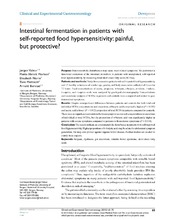Intestinal fermentation in patients with self-reported food hypersensitivity: painful, but protective?
Peer reviewed, Journal article
Published version
Permanent lenke
https://hdl.handle.net/1956/4297Utgivelsesdato
2010-07-03Metadata
Vis full innførselSamlinger
Originalversjon
https://doi.org/10.2147/ceg.s11349Sammendrag
Purpose: Enterometabolic disturbances may cause meal-related symptoms. We performed a functional evaluation of the intestinal microflora in patients with unexplained, self-reported food hypersensitivity by measuring fecal short-chain fatty acids (SCFAs). Patients and methods: Thirty-five consecutive patients with self-reported food hypersensitivity and 15 healthy volunteers of similar age, gender, and body mass index collected all feces for 72 hours. Fecal concentrations of acetic, propionic, n-butyric, i-butyric, n-valeric, i-valeric, n-caproic, and i-caproic acids were analyzed by gas-liquid chromatography. Concentrations and excretions (output) of SCFAs in patients and controls were compared and related to gastrointestinal symptoms. Results: Despite nonsignificant differences between patients and controls for both total and individual SCFA concentrations and excretions, n-butyric acid comprised a higher (P = 0.035) and acetic acid a lower (P = 0.012) proportion of total SCFA in patients compared to controls. There were no significant correlations between symptom scores and concentrations or excretions of individual or total SCFAs, but the proportion of n-butyric acid was significantly higher in patients with severe symptoms compared to patients with moderate symptoms (P = 0.016). Conclusion: The results indicate an enterometabolic disturbance in patients with self-reported food hypersensitivity. Higher proportions of n-butyric acid may be related to abdominal symptom generation, but may also protect against organic bowel disease. Further studies are needed to clarify these aspects.
Utgiver
Dove Medical PressOpphavsrett
Valeur et alCopyright 2010 Valeur et al, licensee Dove Medical Press
